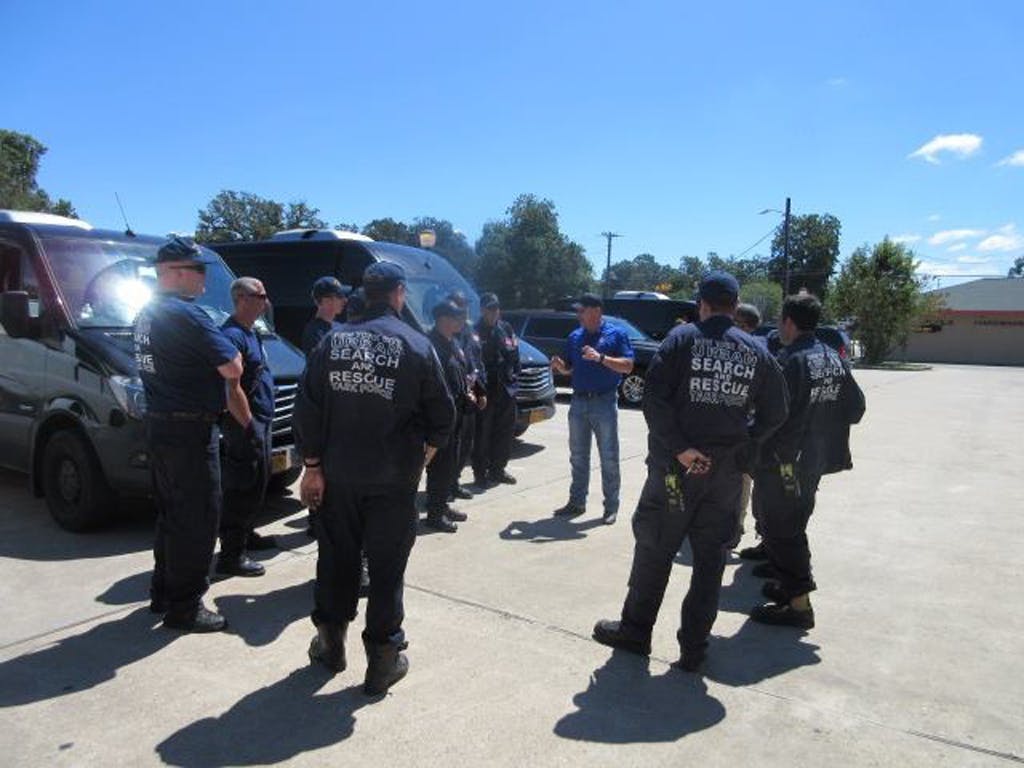Hospital CEO Works with Police, Fire/Rescue and Industry
Scott Briner was in an east Texas hospital when Hurricane Harvey hit the Lone Star State with Category 4 winds and record rainfall in late August — and there’s nowhere else he’d rather have been.
(PICTURED) Scott Briner briefs a search and rescue team from New York as they arrive in Sweeny, Texas.
The 1993 Wilmington College graduate is CEO of a small, critical access hospital in Sweeny, Texas, a community about 20 miles inland from the Gulf of Mexico. It is an hour northeast of Rockport — where the hurricane eye-wall first made landfall at peak intensity Aug. 28 — and southwest of Houston, which had sections inundated with more than four feet of rainfall.
“We were on the dirty side of the hurricane — east of the eye. We suffered lots of heavy rain bands and high winds that hit the same areas repeatedly,” he said.
Briner holds a leadership role on Sweeny’s emergency management response team. He helped coordinate cooperative efforts between law enforcement, fire and rescue, medical care services and the local petroleum industry. Briner is certified by the Federal Emergency Management Agency (FEMA) and was trained through the National Incident Management System (NIMS) for advanced certification for incident command.
“I believe I am a servant-based leader,” he said. “It was an unbelievable feeling to be involved and around people who are so focused on helping the community in a time of disaster.
“My focus was to apply the training I’ve had in my career — I was fortunate I had the ability to help serve my community,” he said. “I have a compassionate, dedicated team that went well above and beyond to see that our community got the care it needed.”
For Briner, hurricane preparedness began when Harvey became a named tropical storm Aug. 17 — some 10 days before it ravaged Texas. He sets into motion a protocol whenever a storm in the Atlantic Ocean or Gulf of Mexico attains named status.
He monitored Harvey, which became the first major hurricane to hit the United States mainland in 12 years, as it made its way, at first, relatively harmlessly through the Windward Islands and near Barbados before it even weakened and degenerated north of Colombia. But, as unpredictable tropical storms often do, Harvey redeveloped its shape and gained strength over the warm waters of the Bay of Campeche near Yucatan. Harvey quickly intensified into a Category 4 hurricane with 130 mph sustained winds as it slammed into Texas.
“This hurricane developed very fast,” Briner said.
After 10 years in Texas — nine as a hospital administrator in Lake Jackson before taking over the facility in Sweeny — he’s no stranger to hurricanes. Indeed, he rode out Hurricane Ike in 2008 with its Category 3 winds. But Harvey was different. It’s catastrophic destructiveness came as a result of an ability to literally hover over east Texas for days, pounding it with as much as 52 inches of rain.
“The hurricane lasted an extreme period of time,” he said. “It stalled and sat right on top of us.”
The combination of rainfall and river flooding forced Briner to call for the evacuation of patients from Sweeny Community Hospital, which he and his team accomplished without incident.
Briner spent more than 48 consecutive hours at the hospital during the brunt of the hurricane and subsequently embarked upon 16-hour days for the next two weeks. He returned to his home in nearby Clute, only eight miles from the Gulf, literally just to sleep. He and staff members often hitched rides home in ambulances, which could maneuver through flooded streets. The hospital reopened several days later and its 185 employees resumed caring for patients, which included issuing tetanus vaccinations to stave off waterborne disease with expanded evening and weekend hours of operation.
In speaking with a sleep-deprived Briner barely two weeks after Hurricane Harvey was finally in the rear-view mirror, he was unable to issue an “all clear” pronouncement, as he was closely monitoring three active named storms, including Category 5 Irma, which wrought a path of destruction through Florida and several Caribbean islands.
“We’re back in preparedness mode,” he said.
Such is hurricane season in east Texas.
NOTE: Scott Briner graduated from Wilmington College in 1993 with majors in athletic training and psychology. He first worked as a mental health technician at a psychiatric hospital in Dayton before pursuing opportunities in health care administration. Briner earned a Master of Business Administration degree from Indiana Wesleyan and is certified by the American College of Healthcare Executives. He is CEO of Sweeny Community Hospital, which annually cares for 25,000 patients from a 25-mile radius around Sweeny, Texas. The critical access facility, which is supported from property taxes, typically has 6,000 emergency room visits annually and grosses $25 million. It has 185 employees with five active medical staff and 60 physicians, most of whom are employed there on a consulting basis.
